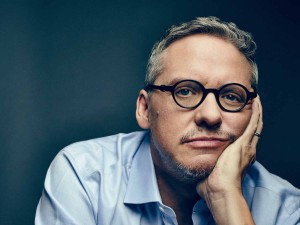
In the book and film, the story of the credit and housing collapse of the mid-2000s is told through the perspectives of four outsiders who predicted the financial turmoil and decided to take on the big banks who precipitated the debacle.
In his page-tuner read, McKay was immediately attracted to these wounded outsiders. Through them, he learned about the financial crisis that most people still do not understand. In the current cultural climate, where people’s beliefs and understanding of things seem to have no connection to facts or numbers or data, he saw the film as an opportunity to, “set the record straight.”
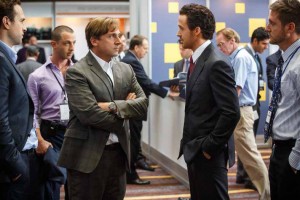
“It was one of those rare times when I had my dream cast on a cork board while I was writing. We actually got the whole dream cast,” revealed McKay. “I’ve never really had that happen before. It was crazy that we got those people, but then Francine Maisler our casting director. She is so good.”
The film has a large cast and McKay didn’t have people in mind for all parts. Maisler brought Finn Wittrock (Jamie Shipley) and John Magaro (Charlie Geller) to the director’s attention and pushed hard for those characters. With the help of Maisler and casting director, Kathy Driscoll, McKay felt they had a dream cast that was rounded out with “all these amazing actors.”
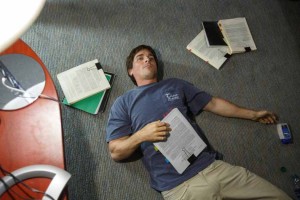 The production also had good day player casting with New Orleans casting director, Meagan Lewis, who had worked on Django Unchained. McKay did not want one line or one moment that might “lose the thread on this movie,” he explained, “I was really happy. We did this mix of real people with actors. It had this real authentic feel to it.”
The production also had good day player casting with New Orleans casting director, Meagan Lewis, who had worked on Django Unchained. McKay did not want one line or one moment that might “lose the thread on this movie,” he explained, “I was really happy. We did this mix of real people with actors. It had this real authentic feel to it.”
McKay wanted the film to open up a conversation with the audience. To do so he used a key device: that of a character breaking out of the scene and talking directly to the viewers. Using this method, he was able to explain complex financial dealings in a way that was accessible to the public or make tongue-in cheek remarks in keeping with the irreverent tone of the film.
Breaking the fourth wall was not the only approach to the film that was atypical. McKay did not want to present a Wall Street of big stone buildings, all blue and grey and static.
 McKay told cinematographer and camera operator, Barry Ackroyd, “I want this hybrid visual style like you shoot.” He wanted a blend that was part verite documentary shooting and part traditional filmmaking. They developed a verite scale from one to 10 and used that to communicate the percentage of documentary versus traditional camerawork to use in a scene.
McKay told cinematographer and camera operator, Barry Ackroyd, “I want this hybrid visual style like you shoot.” He wanted a blend that was part verite documentary shooting and part traditional filmmaking. They developed a verite scale from one to 10 and used that to communicate the percentage of documentary versus traditional camerawork to use in a scene.
The filmmakers built the picture of the financial collapse, piece by piece, character by character. Instead of showing a character in one shot, McKay and Ackroyd revealed close-up bits of the character until the whole was assembled.
To help him assemble that whole picture, McKay tapped Hank Corbin, who had edited serious fare for directors such as Terrence Malick and Bennett Miller, but confessed to McKay that he had never cut comedy. Corbin was on a short list of editors being considered for the film’s ambitious plans. It took McKay about 40 seconds to realize Corbin was the right person for the film.
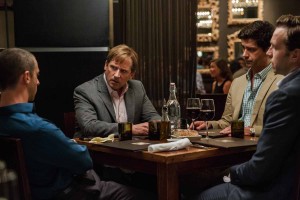 “Hank had read the script. He told me he liked to try things,” said McKay. That approach to editing would fit into the “live-by-the-seat-of-our-pants” improvisational way the writer/director worked.
“Hank had read the script. He told me he liked to try things,” said McKay. That approach to editing would fit into the “live-by-the-seat-of-our-pants” improvisational way the writer/director worked.
Corwin visited the company in New Orleans, where most of the film would be shot. According to McKay, the editor was scouting them out as much as he was courting the editor. The director suggested Corwin watch the film that inspired him, 24 Hour Party People, with its fast-paced, unconventional narrative and satiric-telling of true events. After viewing the film, Corwin got excited.
Pop culture and news montages in the film put the events of the story into place and time. The montages evolved in editorial from what had been scripted. McKay had written incidental images that were more atmospheric, like a monitor in front of a building that would be playing a commercial, or passing the Virgin Megastore and hearing a Shakira video playing. The production learned pretty quickly that getting the rights for those videos and music, even shooting those buildings, was very difficult to do.
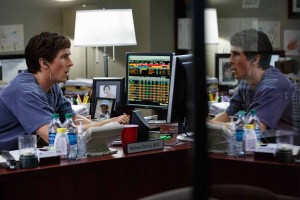 “We were kind of trying to figure it out,” McKay revealed. “Hank just came to me with this idea: you can just put these images in the movie and if we build a language where you’re using this Ludacris video and you’re cross-cutting it with Christian Bales’ character buying the CDSs, that’s okay because now you’ve let pop culture leak into the movie.”
“We were kind of trying to figure it out,” McKay revealed. “Hank just came to me with this idea: you can just put these images in the movie and if we build a language where you’re using this Ludacris video and you’re cross-cutting it with Christian Bales’ character buying the CDSs, that’s okay because now you’ve let pop culture leak into the movie.”
For McKay, suddenly the whole world felt bigger. Using subliminal flashes of pop culture and little chapter headings with quotes on them, the movie began to tell the story of America, ultimately bringing home the tragedy of the crash – people’s possessions thrown out on the street, the tent cities, losing everything. The film was no longer just the story of these people in their Wall Street offices.
“That was probably the biggest post breakthrough,” shared McKay who acknowledged the editor’s talent. “His eye is something to behold.”
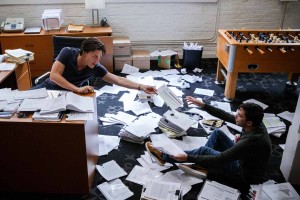 About 70% of the film was shot in New Orleans. The Gulf coast near New Orleans was perfect because there was an area that looked just like Florida with a big casino in the middle of town. There were even enough hi-rises to simulate Manhattan skylines. With a week in New York City and half a week in Vegas, the production was able to round out the locations.
About 70% of the film was shot in New Orleans. The Gulf coast near New Orleans was perfect because there was an area that looked just like Florida with a big casino in the middle of town. There were even enough hi-rises to simulate Manhattan skylines. With a week in New York City and half a week in Vegas, the production was able to round out the locations.
Production designer Clayton Hartley, has worked with McKay since his first film. The director thinks The Big Short is some of the best work that he has done. “The guy consistently blows me away. He did fabulous work on this movie. He is super crafty as far as the locations we would find. He always made sure there were textures and layered glass so the camera could have some life.”
Shooting through glass into and through offices added metaphorical layers to the story. Hartley likes working with layers, having glass and textures, but the difference on this film was how much Ackroyd also desired those qualities. The team was even conscious of the textures on the walls, especially since they were going to shoot in an impressionistic style.
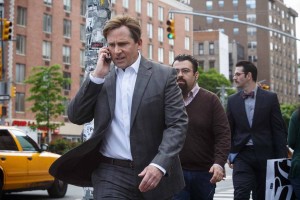 “It was really remarkable to watch. I always had the idea of the layers to separate the people, in a written way it was there, but when Clayton and Barry got together it sort of got a rocket boost. I felt the two of them started speaking the exact same language. It was very exciting,” said McKay.
“It was really remarkable to watch. I always had the idea of the layers to separate the people, in a written way it was there, but when Clayton and Barry got together it sort of got a rocket boost. I felt the two of them started speaking the exact same language. It was very exciting,” said McKay.
McKay called composer Nicholas Britell, “A force of nature.” The composer came onto the production very early. He told the director that he was coming into town and set up a little office across from the cutting room. The director didn’t know what the composer was planning. He just thought Britell would “noodle around.”
“He had already written a couple of beautiful pieces that were cutting quite nicely into the movie. What it ended up becoming was this moment to moment collaboration,” explained McKay. “I was usually in with Hank. Nicholas could pop into Hank’s room and plug his keyboard into the Avid. Hank would play with a cut, while Nick would play with scoring. Watching it in actual time was so exciting!”
Hank could also pop across the hallway when he needed a piece of music, and within an hour, Britell would have a piece of music to try in the cut. McKay loved the organic process of having the composer in close proximity to the editing and the ability to score as the cut was being finessed. Many times he would come in to discover that the editor and composer had perfected a scene the night before.
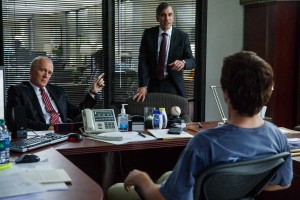 “We’ve all kind of walked away saying, ‘Why isn’t it done this way all the time?’ In the future I will be working with Hank and Nick again. And in the future, we will definitely be bringing Nick in early. It really was a massive boon to the movie. It helped a lot,” declared McKay. “I’ll never do it another way.”
“We’ve all kind of walked away saying, ‘Why isn’t it done this way all the time?’ In the future I will be working with Hank and Nick again. And in the future, we will definitely be bringing Nick in early. It really was a massive boon to the movie. It helped a lot,” declared McKay. “I’ll never do it another way.”
The close collaboration made the process even more fun. “It got the ideas bouncing off the walls at a higher velocity,” added McKay.
McKay described sound supervisor, Becky Sullivan, as “artful” and “vigilant.” She really worked the film with a level of care that McKay had never seen before. The director went into the mix wanting to use production dialog and was able to do so because of the quality of the audio recorded by production sound mixer, David Wyman. McKay credited re-recording mixers, Anna Behlmer and Terry Porter for the artful way they were able to transition in and out of that documentary style while occasionally going into full Hollywood movie style.
The characters were unusual outsiders with strange looks. Susan Mathesan, the costume designer, would be up at four in the morning looking for a certain kind of dress shirt on eBay that she would find in Minnesota that had to be shipped to the production. Adruitha Lee, department head stylist and make-up department head, Julie Hewett, got the looks “just perfect.”
“All the below-the-line, everyone, really had an extra love for the movie. I kept calling it our dream team,” McKay stated. “We did not have one weak link.”
“It sure makes filmmaking a whole lot easier when you get a line up of passionate professionals like this. I think it’s the subject matter, too. I think it’s a subject we were all passionate about,” McKay concluded. “We felt like there was potentially something here that could be really exciting, so you could always feel that extra 10% from everyone.”





